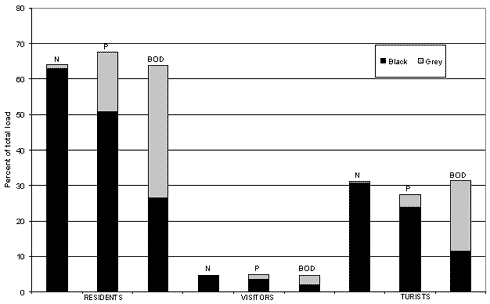|
Muligheder for økologisk spildevandshåndtering på Christiansø Summary and conclusionsChristiansø is a group of small rocky islands situated to the Northeast of Bornholm in the Baltic, Denmark. The islands have almost no wastewater handling at present, resulting in hygienic problems due to emptying of latrines on the surface and discharge of untreated wastewater from households and fishing industry into a harbour with visiting tourists and further into the Baltic. A conventional treatment plant (mechanical/biological/chemical) has been proposed, however at high costs. The purpose of the study reported here was to come up with other suggestions, possible leading to reduced costs and increased sustainability. The results are based on a larger research project on sustainable wastewater handling financed by the Danish EPA and have relevance for other small and remote islands with no or limited wastewater handling. Christiansø is owned by the Ministry of Defence and is not under the jurisdiction of any county or other environmental regulatory body. Thus, it has been difficult to determine a "required" level of wastewater treatment; any decision concerning a future solution must be made in collaboration between the administrator in place and the Ministry of Defence in Denmark. If no action is taken by any of these parties, the problems remain unsolved. The islands have about 100 residents with a maximum capacity of 135. In the summertime (about 2 months) many visitors (regular visitors, visitors in cabins, campers and sailors) and tourists (visiting for about 3 hours) come to the islands. In total, about 635 Pe are present each day during the summer period. The load of nutrients (as NH4+-N and total P) and organic matter (BOD5) is illustrated in figure 1. It is noted that the sum of all the population groups, is 100 % for each component. According to figure 1, the major load of nutrients and organic matter comes from the residents (about 100 Pe) and the tourists during the summer period. Any solution should consider this load distribution. Subsequently it is recognised that more than 50 percent of both N and P are found in the black wastewater from the residents.
Figure 1: The geology of Christiansø is characterized by bedrock with a thin soil layer. The islands are preserved by a provision that comprises all life and buildings; import of foreign plants is not permitted and there is no agriculture. These preconditions have major impact on the possibilities for implementing solutions such as constructed wetlands and sandfilters because of high construction costs and space demand. Also, they do not favour solutions based on local recycling of nutrients and excreta. With reference to a gross list of alternative options for wastewater handling and a thorough analysis of the location, the solutions in figure 2 have been proposed for Christiansø.
* mechanical/biological/chemical treatment (only mechanical ~ expected
demands) Figure 2: Subsequently, mass balances have been made in order to evaluate the load on the environment (i.e. the Baltic) by implementing the different solutions. The ‘expected demands’ are based on the present regulation (only mechanical treatment for smaller plants - a few 100 Pe) in the county of Bornholm (same recipient, similar geological conditions etc.). Figure 2 shows that the solution with urine separation, as expected, is the most effective solution towards reducing the nutrient load on the Baltic. It also shows that all the proposed solutions (except ‘ long pipes’ and ‘public vacuum toilets alone’) can fulfil the expected demands. Reducing the discharge of nutrients and organic matter to the Baltic is however not the only issue to consider. A number of criteria were used in order to evaluate and assess the sustainability of the different solutions and making a decision with regard to the wastewater problem at Christiansø:
These criteria were set up in a matrix with the different solutions. Subsequently, an assessment (mostly qualitative) was made to evaluate the performance of each solution compared to the existing conditions. The solutions were rated by ---, --, -,0,+,++,+++, where 0 means that the solution will not lead to any change of the existing conditions. The multi criteria analysis made it possible to put forward a recommendation on the future wastewater handling at Christiansø. It has, controversially, been concluded that the most sustainable solution would be improving the existing sewage collection system and extend it with a long pipe (about 300 m) into the Baltic. This would solve the hygienic problems (i.e. emptying of latrine into the surroundings and discharge of wastewater directly into the harbour), and the choice of ‘no treatment’ is justified by the limited pollution load to the Baltic compared with other land-based sources from the surrounding countries. Most of the other solutions would involve higher costs or the need for transportation of human waste products, which would involve potential hygienic problems and increased energy consumption.
|
|||||||||||||||||||||||||||||||||||||||||||||||||||||||||||||||||||||
